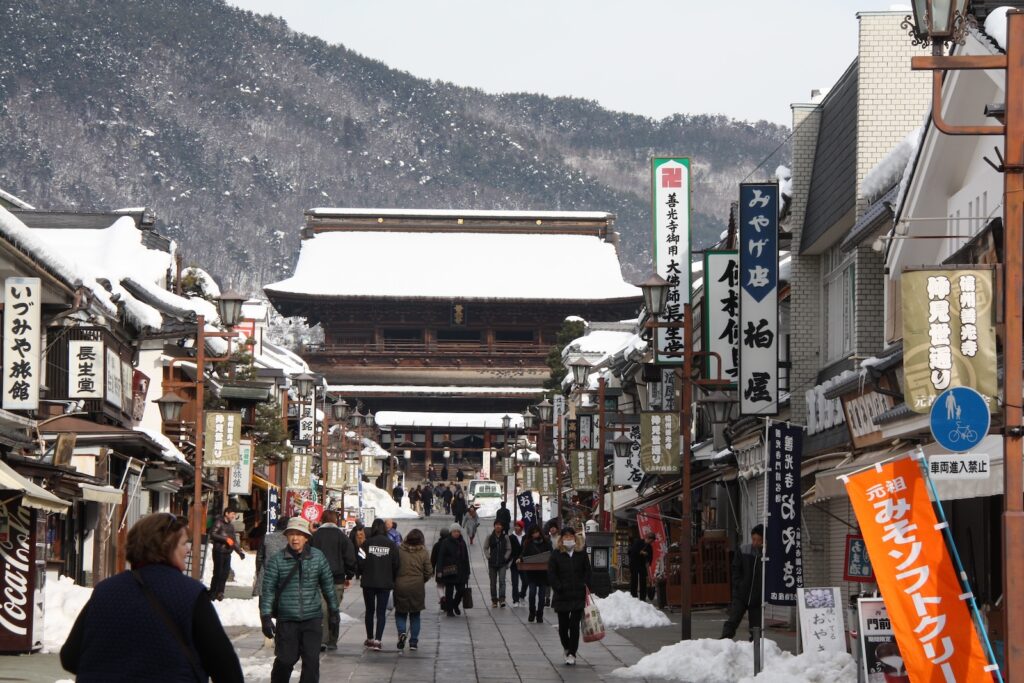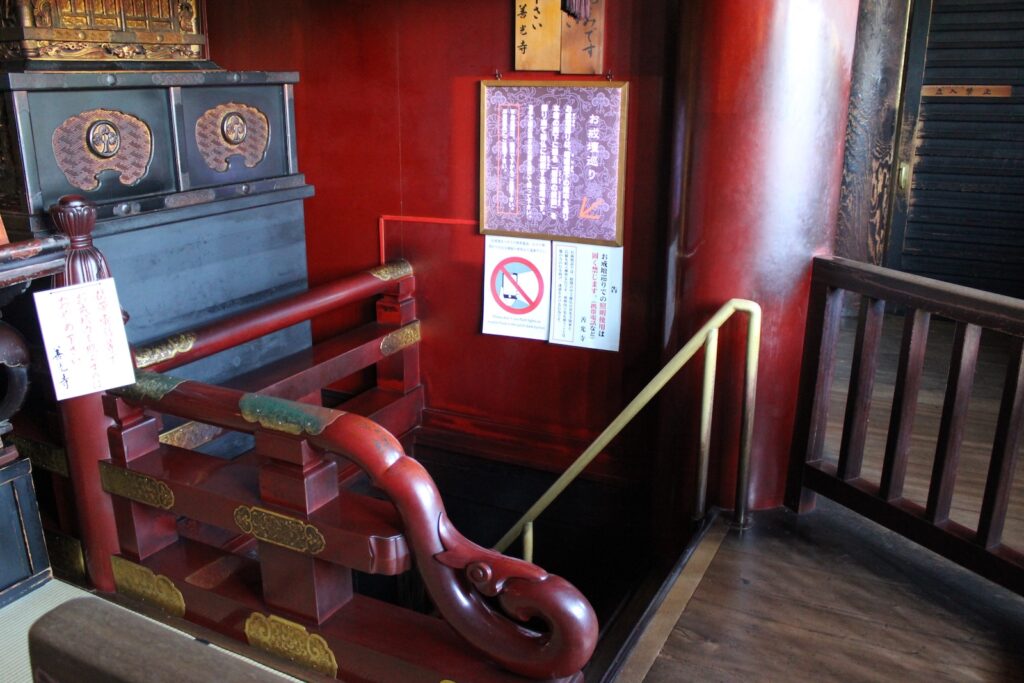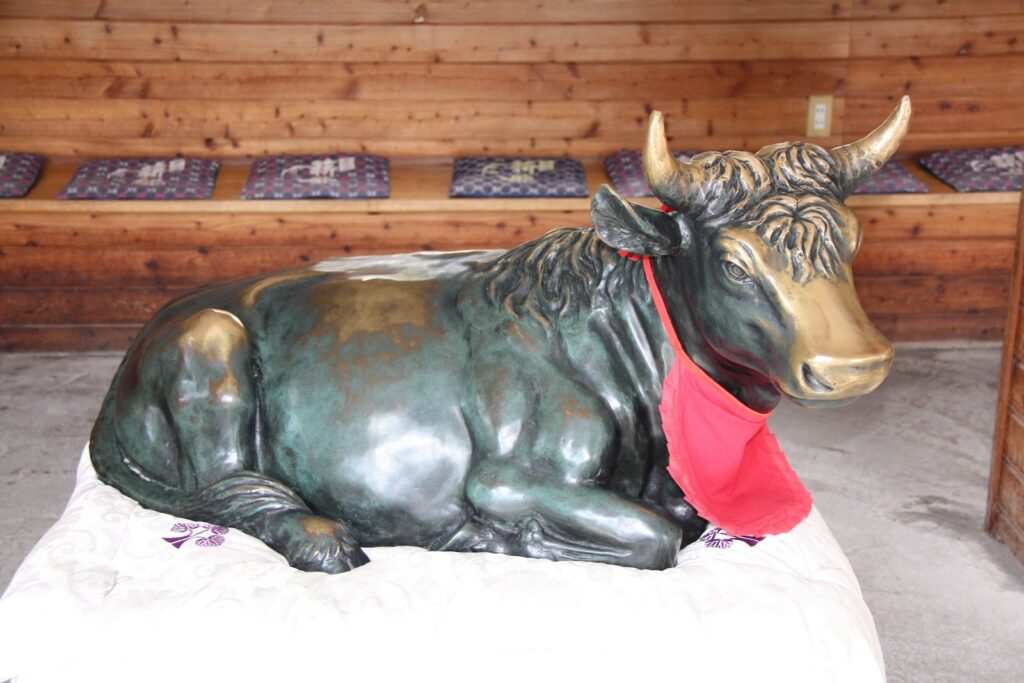Shinshu Zenkoji Temple is one of the most famous temples in Nagano Prefecture and throughout Japan. With a history spanning over 1,400 years, it enshrines the oldest Buddhist statue in Japan as its principal object of worship.
To introduce the allure of Zenkoji, I will discuss the following four topics:
- The principal object of worship, sought by renowned Sengoku warlords.
- From disaster relief to becoming Japan’s largest temple for the common people.
- A lock that, when touched, allows anyone to reach paradise.
- A temple where everyone can worship equally, regardless of gender.
The principal object of worship, sought by renowned Sengoku warlords.

Zenkoji Temple has long attracted devotees, and by the late Heian period, it had become the most sacred site in the eastern provinces. During the Kamakura period, powerful figures like Minamoto no Yoritomo and the Hojo clan deeply revered Zenkoji. In the Sengoku period, many famous warlords cherished Zenkoji and its principal object of worship.
The story begins with Takeda Shingen of Kai Province (present-day Yamanashi Prefecture) and Uesugi Kenshin of Echigo Province (present-day Niigata Prefecture). During the Sengoku period (16th century), they fought five times over control of Shinano (present-day Nagano Prefecture). These battles are known as the Battles of Kawanakajima.
During that time, many battles took place around Zenkoji, and fearing that the flames of war would reach the temple, Takeda Shingen moved.Zenkoji to Kai Province in 1555 (the first year of the Koji era). Shingen moved Zenkoji to Kai Province. After the Takeda clan was defeated by the Oda-Tokugawa allied forces in the Battle of Nagashino, the principal object of worship from Zenkoji was taken to Gifu by Oda Nobutada, the son of Oda Nobunaga. After Nobutada and his father committed suicide during the Honnoji Incident, Nobutada’s younger brother Oda Nobukatsu moved the principal object of worship to Owari (present-day Aichi Prefecture), and the following year, Tokugawa Ieyasu took it to Hamamatsu.
Later, Toyotomi Hideyoshi, who had unified Japan after the Sengoku period, decided to enshrine the object at Hokoji Temple in Kyoto. However, in 1598, the third year of the Keicho era, the principal object of worship was returned to Zenkoji in Shinano.
Thus, after about 40 years, Zenkoji’s revered principal object of worship, cherished by many famous warlords, was finally returned to Shinano.
Under the patronage of Tokugawa Ieyasu, who founded the Edo Shogunate, Zenkoji continued to attract many visitors, a tradition that continues to this day.
From disaster relief to becoming Japan’s largest temple for the common people.

At Zenkoji Temple, the Gokaicho (Opening of the Temple) is held every seven years.
Since Zenkoji’s principal object of worship, Ikko Sanzon Amida Nyorai (One Amida with Three Attendants), has been a hidden Buddha since the year 654 (Hakuchi 5), a substitute statue called Zendatsu Honzon was created in the Kamakura period. This statue is usually kept in the temple’s treasure house, but during the Gokaicho, it is specially revealed to the public. The most recent Gokaicho in 2015 drew about 7 million visitors.
However, this Gokaicho tradition actually started in the Edo period, spurred by one of the greatest natural disasters in Japanese history: the Great Eruption of Mount Asama.
On July 8, 1783 (in the old lunar calendar), the eruption of Mount Asama claimed around 1,500 lives.
In response to this tragedy, Zenkoji’s head priest, the 80th Dai-Kanjin Tōjun Daisōjō, personally went to the disaster-stricken village of Kambara in Tsumagoi, Gunma Prefecture. He provided food and money to 3,000 survivors, recited nembutsu prayers with them, and created and distributed the Yūzū Nembutsu Ketchimyaku (a spiritual passport to paradise). In the following year, 1784, a large memorial service was held at Zenkoji for the victims of the Asama eruption. Tōjun Daisōjō sent memorial wooden tablets (kyoki tōba) inscribed with the names of all 1,490 victims to the disaster area. In 1785, the first memorial ceremony (eko) was held at Zenkoji’s main hall, marking the first Gokaicho (also known as Kyo-Gokaicho) ever held at the main hall.
Hearing of these compassionate deeds, people from all over Japan began visiting Zenkoji to receive the O-Ketchimyaku amulet. Tōjun Daisōjō distributed as many as 1.8 million of these O-Ketchimyaku amulets, and he was revered as a living Buddha. From that time on, Zenkoji became renowned as one of Japan’s leading temples for the common people.
A lock that, when touched, allows anyone to reach paradise.

Zenkoji Temple was founded shortly after the introduction of Buddhism to Japan and is a non-denominational temple. However, it is currently maintained and managed through the joint efforts of the Tendai and Jodo sects. The principal image (gohonzon) enshrined in the innermost sanctuary of Zenkoji’s main hall is an absolute secret, meaning it cannot be seen. However, by walking through the corridor beneath the floor of the Ruridan, where the sacred altar is located, and touching the “Lock of Paradise,” it is believed that one can establish a connection with the principal image and secure a promise of rebirth in paradise.
This act of walking beneath the sacred altar is called the Okaidan Meguri.
The pitch-black corridor directly beneath the principal image symbolizes complete darkness. During the Edo period, commoners may have found reassurance, or a glimmer of hope, in the belief that touching the lock in this darkness would guarantee them a place in paradise.
Incidentally, paradise is paired with hell. Interest in the afterlife (paradise and hell) increased during the Heian period, when the monk Genshin depicted the world of hell in his work Ojoyoshu (The Essentials of Rebirth).
This world of hell was also depicted in paintings, and by the Edo period, many such “Hell Scrolls” were created. As a result, the image of hell became widespread among commoners. In the midst of this, many sought to visit Zenkoji, as it was believed that worshipping the principal image at the temple would guarantee entrance to paradise.
This widespread popularity of Zenkoji even influenced the Japanese comedic art of rakugo during the Edo period, giving rise to a story called “Okechimyaku” (The Bloodline). The premise is that since everyone can go to paradise, no one will fall into hell. In this humorous story, King Enma, the ruler of hell, laments that there are no more souls falling into hell due to the spread of faith in Zenkoji. This reflects just how many people during that time placed their faith in Zenkoji.
A temple where everyone can worship equally, regardless of gender.

Zenkoji Temple is unique in that it has been a place of worship open to all people, regardless of sect, as it existed before Buddhism in Japan was divided into various schools. The temple’s teachings, which emphasize that “anyone who recites the nembutsu and prays sincerely will be led to the Pure Land, regardless of gender or social status,” advocate for universal salvation. As a result, it was believed that even visiting the temple just once guaranteed rebirth in the Pure Land. This belief led to the popular sayings during the Edo period, such as “Even if far, visit Zenkoji once,” and “Once in a lifetime, visit Zenkoji.”
The idea of “anyone” also included women.
In Japan, there was once a custom known as nyonin kinsei (“prohibition of women”), which forbade women from entering certain sacred places or pilgrimage sites for religious training. Although this practice was largely abolished after the Meiji government’s decree in 1872 allowing women to enter such places, during the Edo period, many temples strictly enforced this prohibition. However, Zenkoji allowed women to enter its main hall.
A well-known phrase related to women and Zenkoji is “Led by a cow to Zenkoji.”
This phrase comes from a folk tale about an old woman with no religious faith who, while chasing after a cow that had taken a piece of cloth she was bleaching, ended up at Zenkoji. After this incident, she became a devout believer. This story suggests that Zenkoji was believed to guide even non-believing women toward faith. In fact, one characteristic of Zenkoji pilgrimage was the large number of female visitors.
As a temple that offered salvation equally to all, regardless of social class, age, region, or gender, Zenkoji attracted widespread faith, and from this, these expressions were born.
【The Only Event Where You Can Tour Shinshu Zenkoji Temple with the Resident Priest as Your English Guide】
Shinshu Zenkoji Temple, beloved by so many throughout history.
The upcoming event, “Zenkoji Temple Special Experience with Nagano Wine Premium Dinner featuring ‘Drops of God,'” offers a rare opportunity to tour the temple while hearing directly from Zenkoji’s resident priest.
Additionally, you will have the chance to participate in religious ceremonies at both Zenkoji Daikanjin and Zenkoji Daihongan, and enjoy a special collaboration: a gourmet dinner at Daikanjin, curated by Marriott Hotels, paired with exquisite Nagano wine.
Don’t miss this exclusive opportunity!
